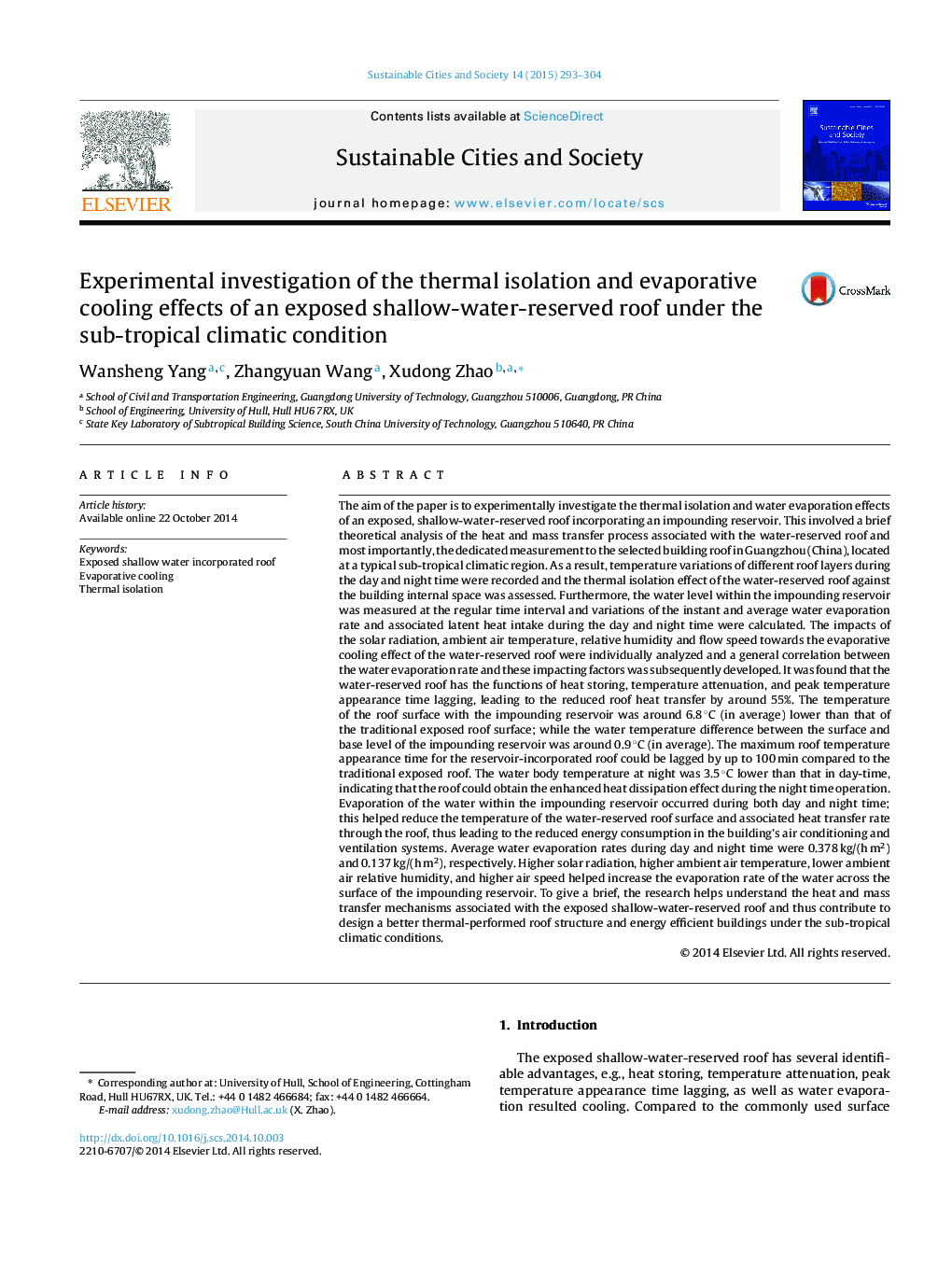| کد مقاله | کد نشریه | سال انتشار | مقاله انگلیسی | نسخه تمام متن |
|---|---|---|---|---|
| 6776589 | 513530 | 2015 | 12 صفحه PDF | دانلود رایگان |
عنوان انگلیسی مقاله ISI
Experimental investigation of the thermal isolation and evaporative cooling effects of an exposed shallow-water-reserved roof under the sub-tropical climatic condition
ترجمه فارسی عنوان
بررسی تجربی از انزوا گرما و اثرات خنک کننده تبخیری یک سقف محفوظ در معرض کم عمق آب تحت شرایط آب و هوایی زیر طرابلس
دانلود مقاله + سفارش ترجمه
دانلود مقاله ISI انگلیسی
رایگان برای ایرانیان
کلمات کلیدی
سقف پوشش داده شده کم عمق سقف، خنک کننده تبخیری جداسازی حرارتی،
موضوعات مرتبط
مهندسی و علوم پایه
مهندسی انرژی
انرژی های تجدید پذیر، توسعه پایدار و محیط زیست
چکیده انگلیسی
The aim of the paper is to experimentally investigate the thermal isolation and water evaporation effects of an exposed, shallow-water-reserved roof incorporating an impounding reservoir. This involved a brief theoretical analysis of the heat and mass transfer process associated with the water-reserved roof and most importantly, the dedicated measurement to the selected building roof in Guangzhou (China), located at a typical sub-tropical climatic region. As a result, temperature variations of different roof layers during the day and night time were recorded and the thermal isolation effect of the water-reserved roof against the building internal space was assessed. Furthermore, the water level within the impounding reservoir was measured at the regular time interval and variations of the instant and average water evaporation rate and associated latent heat intake during the day and night time were calculated. The impacts of the solar radiation, ambient air temperature, relative humidity and flow speed towards the evaporative cooling effect of the water-reserved roof were individually analyzed and a general correlation between the water evaporation rate and these impacting factors was subsequently developed. It was found that the water-reserved roof has the functions of heat storing, temperature attenuation, and peak temperature appearance time lagging, leading to the reduced roof heat transfer by around 55%. The temperature of the roof surface with the impounding reservoir was around 6.8 °C (in average) lower than that of the traditional exposed roof surface; while the water temperature difference between the surface and base level of the impounding reservoir was around 0.9 °C (in average). The maximum roof temperature appearance time for the reservoir-incorporated roof could be lagged by up to 100 min compared to the traditional exposed roof. The water body temperature at night was 3.5 °C lower than that in day-time, indicating that the roof could obtain the enhanced heat dissipation effect during the night time operation. Evaporation of the water within the impounding reservoir occurred during both day and night time; this helped reduce the temperature of the water-reserved roof surface and associated heat transfer rate through the roof, thus leading to the reduced energy consumption in the building's air conditioning and ventilation systems. Average water evaporation rates during day and night time were 0.378 kg/(h m2) and 0.137 kg/(h m2), respectively. Higher solar radiation, higher ambient air temperature, lower ambient air relative humidity, and higher air speed helped increase the evaporation rate of the water across the surface of the impounding reservoir. To give a brief, the research helps understand the heat and mass transfer mechanisms associated with the exposed shallow-water-reserved roof and thus contribute to design a better thermal-performed roof structure and energy efficient buildings under the sub-tropical climatic conditions.
ناشر
Database: Elsevier - ScienceDirect (ساینس دایرکت)
Journal: Sustainable Cities and Society - Volume 14, February 2015, Pages 293-304
Journal: Sustainable Cities and Society - Volume 14, February 2015, Pages 293-304
نویسندگان
Wansheng Yang, Zhangyuan Wang, Xudong Zhao,
